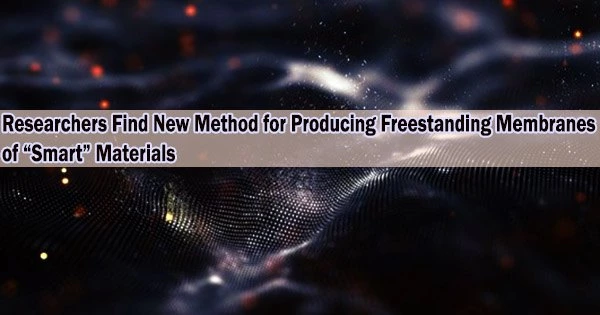Perovskite oxide semiconductors are a class of “smart” materials with distinctive properties that can change in response to stimuli like light, magnetic fields, or electric fields. A team of scientists and engineers led by the University of Minnesota Twin Cities has developed a new technique for producing thin films of these semiconductors.
Researchers will now be able to take advantage of these qualities and potentially combine them with other novel nano-scale materials to create better sensors, smart clothing, and flexible electronics.
The paper is published in Science Advances.
Materials can more easily be integrated into smaller electronic device components by being produced as thin films. Epitaxy, a method used to make many thin films, involves depositing atoms of a material on a substrate, or type of a template, in order to build up a thin sheet of material one atomic layer at a time.
However, the majority of epitaxy-produced thin films are “stuck” on their host substrate, which restricts their applications. The thin film becomes significantly more useful if it is separated from the substrate and made into a freestanding membrane.
A new technique developed by a team lead by the University of Minnesota has been used to successfully synthesize a membrane made of the specific metal oxide strontium titanate. This technique gets around many problems that have previously prevented the manufacture of freestanding metal oxide films.
“We have created a process where we can make a freestanding membrane of virtually any oxide material, exfoliate it, and then transfer it onto any subject of interest we want,” said Bharat Jalan, a senior author on the paper and a professor and Shell Chair in the University of Minnesota Department of Chemical Engineering and Materials Science. “Now, we can benefit from the functionality of these materials by combining them with other nano-scale materials, which would enable a wide range of highly functional, highly efficient devices.”
As opposed to a two-dimensional material like graphene, “smart” oxide materials’ atoms are connected in all three dimensions, making the creation of freestanding membranes difficult. Using a process known as distant epitaxy, which places a layer of graphene between the substrate and the thin-film material, is one way to create membranes out of oxide materials.
We have created a process where we can make a freestanding membrane of virtually any oxide material, exfoliate it, and then transfer it onto any subject of interest we want. Now, we can benefit from the functionality of these materials by combining them with other nano-scale materials, which would enable a wide range of highly functional, highly efficient devices.
Bharat Jalan
With this method, the thin-film oxide material can form a thin film and be pulled away from the substrate like a piece of tape to produce a freestanding membrane. Although the oxygen in the substance oxidizes the graphene on contact, destroying the sample, this is the largest obstacle to employing this procedure with metal oxides.
By utilizing titanium that was already linked to oxygen and a process called hybrid molecular beam epitaxy, developed by Jalan’s team at the University of Minnesota, the researchers were able to circumvent this problem. Additionally, they can automatically adjust the composition thanks to their method’s ability to perform stoichiometric control.
“We showed for the first time, and conclusively by doing several experiments, that we have a new method which allows us to make complex oxide while ensuring that graphene is not oxidized. That’s a major milestone in synthesis science,” Jalan said. “And, we now have a way to make these complex oxide membranes with automatic stoichiometric control. No one has been able to do that.”
The materials scientists on Jalan’s team worked closely with engineering researchers in the University of Minnesota Department of Electrical and Computer Engineering Professor Steven Koester’s lab, which focuses on making 2D materials.
“These complex oxides are a broad class of materials that have a lot of really important innate functions to them,” said Koester, also a senior author of the study and the director of the Minnesota Nano Center at the University of Minnesota Twin Cities. “Now, we can think about using them to make extremely small transistors for electronic devices, and in a wide array of other applications including flexible sensors, smart textiles, and non-volatile memories.”
The U.S. Department of Energy, the Air Force Office of Scientific Research, and the National Science Foundation funded the research.
In addition to Jalan and Koester, the research team included University of Minnesota Department of Chemical Engineering and Materials Science researchers Hyojin Yoon, Tristan Truttmann, Fengdeng Liu, and Sooho Choo; University of Minnesota Department of Electrical and Computer Engineering researcher Qun Su; Pacific Northwest National Laboratory researchers Bethany Matthews, Mark Bowden, Steven Spurgeon, and Scott Chambers; and University of Wisconsin-Madison researchers Vivek Saraswat, Sebastian Manzo, Michael Arnold, and Jason Kawasaki.





